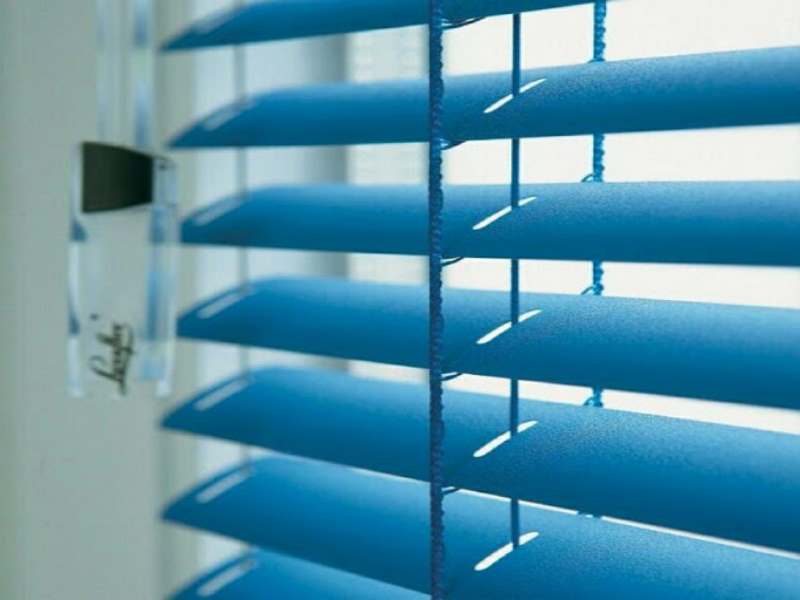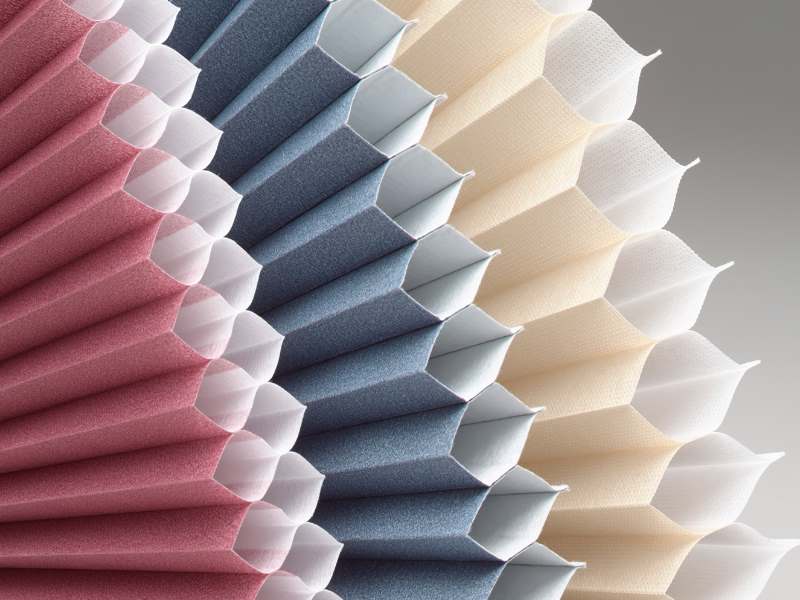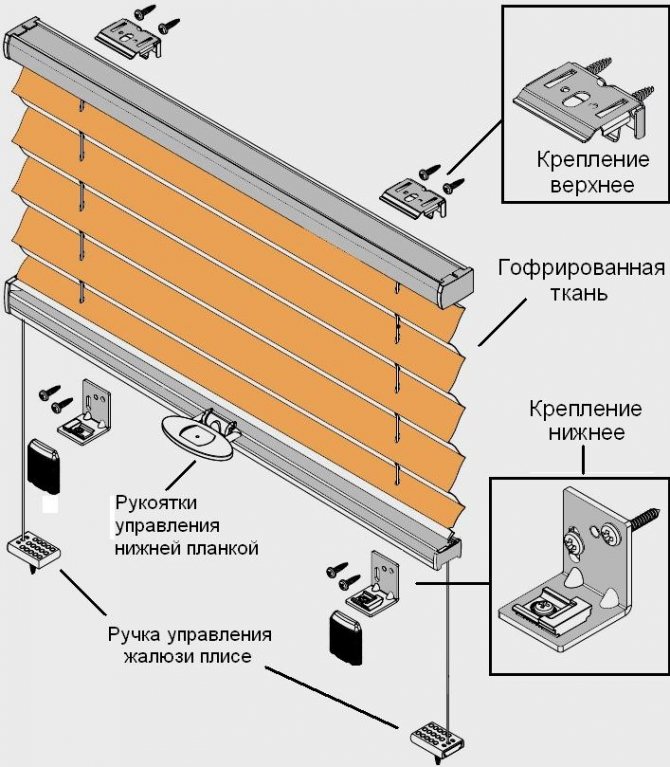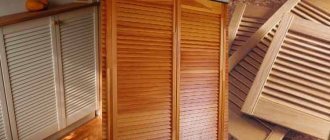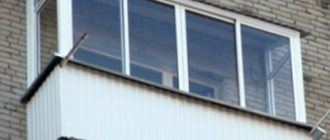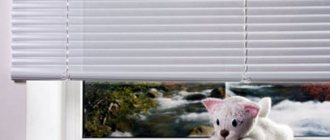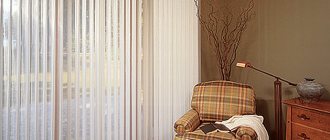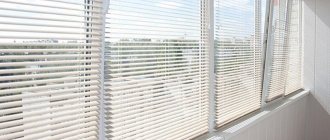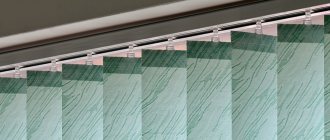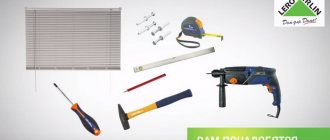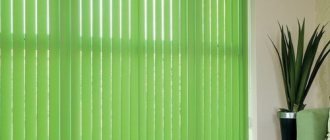12.07.2016
Jalousie
Today there are many types of horizontal blinds for plastic windows, because this type of light filter has been the most popular for many years. Horizontal blinds are perfect for any room, they can fit into any interior, and their merits have been appreciated by almost all buyers.
Horizontal blinds can be used on windows as a sole decoration or paired with tulle or curtains. A variety of installation methods, types of blinds fastening to plastic windows, drawings allow you to choose the ideal option in any situation - for home and office.
We suggest that you familiarize yourself with the descriptions and photos of the types of horizontal blinds for plastic windows.
Correctly selected horizontal blinds can decorate any room
What are horizontal blinds
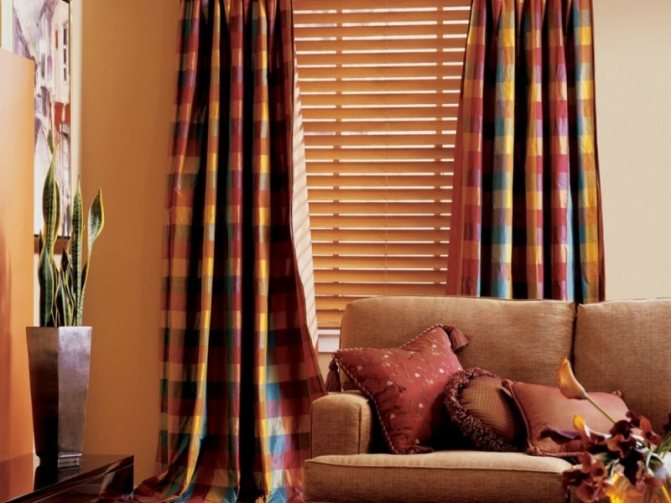
Horizontal (Venetian) blinds are a type of window curtain, consisting of many narrow and long slats (slats, slats), 1.6 to 5 cm wide, located one above the other and interconnected by cords. They are interconnected in such a way that they can rotate about their axis and change the position of the curtain from closed to open.
Ready-made horizontal blinds from the manufacturer are stable. They hardly react even to strong gusts of wind, and they can be fixed almost anywhere. Due to these qualities, such designs are often used instead of interior doors.
Advantages of blinds with horizontal slats:
- Functionality. With their help, it is very convenient to adjust the intensity of the luminous flux.
- A wide range of. The choice of shapes, sizes, colors, materials for the manufacture of such structures is incredibly diverse.
- Aesthetics. Depending on the model, they look avant-garde or vintage, they can be invisible or stand out and easily fit into any interior style.
- Easy care. Components for them are always on sale, so any breakdown can be eliminated quickly and effortlessly.
- Compatibility. Such designs can be used both as an independent decor and in combination with other curtains.
- High consumer characteristics. They are durable and do not lose their performance even in a humid environment and in conditions of a sharp temperature drop.
Web adjustment
Built-in blinds are supplied with the following types of adjusting mechanisms:
- The revolving handle is an easy-to-install but inconvenient option. Many manufacturers are rejecting such mechanisms. If the handle is installed, it is used to adjust the angle of inclination of the slats.
- Magnetic block. Blinds are easy to operate. A simple handle is used to change the position of the slats. Both the angle of inclination and the height of the built-in curtain change.
- Roller device. The classic version includes a cord and a wheel that sets in motion all the details of the structure. Such mechanisms are often installed in external types of blinds.
- Shaft. Horizontal blinds are equipped with a longitudinal tube rotating around its axis. The cords quickly wind the web around the sleeve. The latter can be installed hidden, which does not violate the aesthetics of the structure.
- The electronic unit. The electric motor sets the lamellas in the desired position. A remote control is used to control the system. It is the most reliable and cost effective option.
Design features
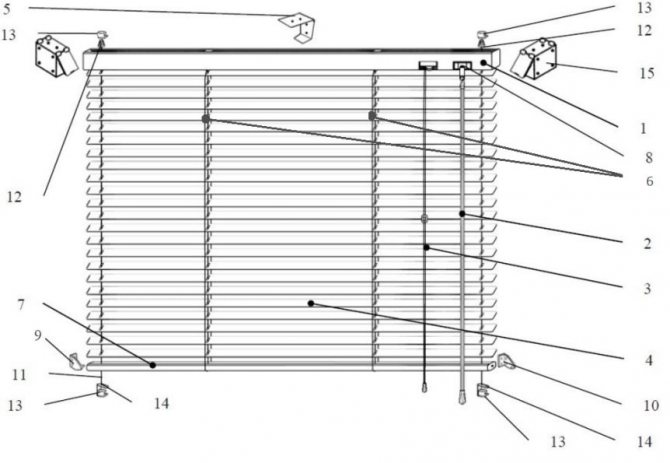

Average statistical scheme of horizontal blinds:
- U-shaped bar.
- Walking stick.
- Control cord.
- Lamella.
- Universal mount.
- Rope ladder.
- Lower weight bar.
- Swivel mechanism.
- Right bottom retainer.
- Left lower retainer.
- Stretch line.
- Clip.
- Plug.
- Button.
- Top side cover.
In blinds for plastic windows with strips located one above the other, a system called "ladder" is used. The curtains are raised and lowered by means of a rotating drum, which is driven by a special cord. With the same cord, the curtain is fixed in the desired position. The lamellas are turned around the axis using a cane. This type of cord-and-stick control is used in standard models. In modern improved models, all three processes (lifting, turning and fixing the planks) are carried out by the same chain.
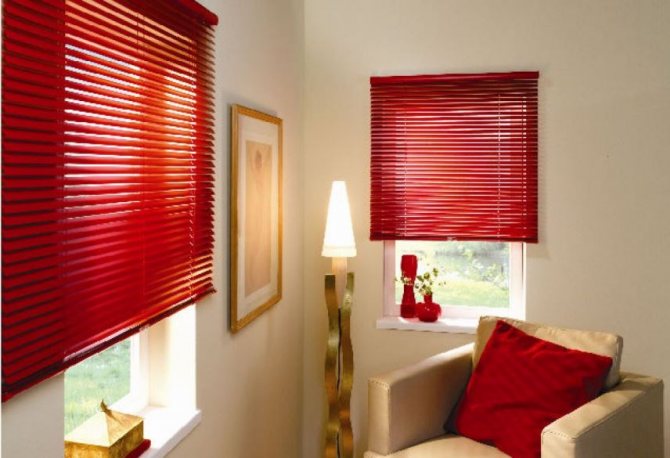

Installation "on the opening" of the window.
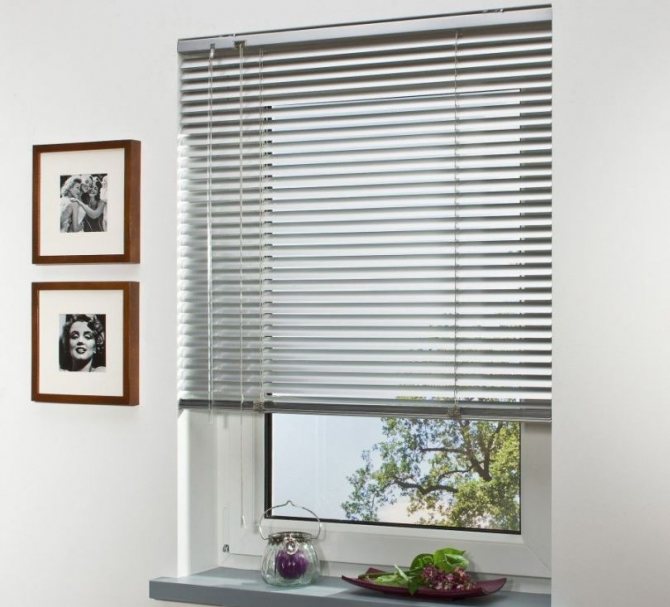

Installation "in the opening" of the window.
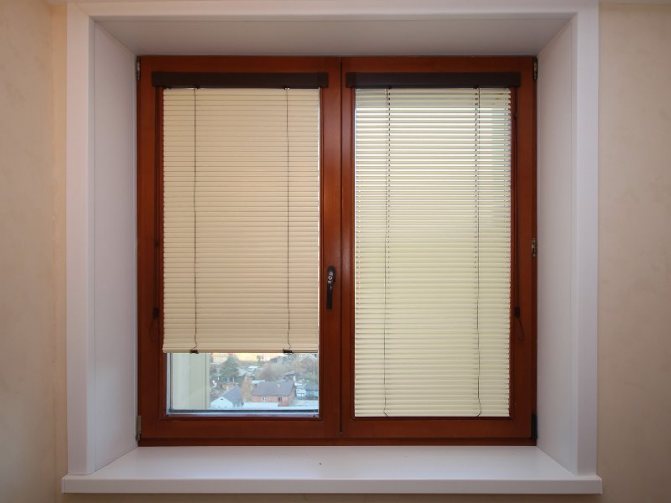

Installation "on the sash" of the window.
The device of blinds with a horizontal arrangement of lamellas is thought out in such a way that with their help it is very convenient to control the luminous flux. According to this indicator, not a single curtain can be compared with them. By turning them at different angles, you can achieve any degree of illumination:
- in the position "parallel with the wide part to the window", the slats are closed at the edges and create complete shading;
- in the position "parallel with wide parts to each other" they do not trap light and let it into the room to the maximum;
- when tilted, they create partial shading, the degree of which depends on the angle of inclination.
It is also convenient that, depending on the model, horizontal systems can be installed on windows both on the entire window opening, and on each sash separately. The main thing is to measure the dimensions correctly. In the latter case, we save space, and the window sill remains completely free.
Another type of such blinds for windows is roller shutters. As a rule, they are installed from the outside of window and door openings. Such models differ from ordinary ones by the presence of side guides along which the slats move. When these canvases are completely lowered, they can be locked. That is why they are often used as protection for shop windows.
Scope of application
Louvered windows inside a double-glazed unit are versatile.
They are installed in the following rooms:
- Public institutions with high requirements for cleanliness of rooms. These include clinics, swimming pools, kindergartens, schools. In such buildings, light level control is required, especially in the summer. In this case, it is necessary to comply with sanitary standards.
- Office centers. Recessed blinds with a magnetic mechanism are used in the construction of partitions between workplaces, entrance doors and windows.
- Residential buildings and apartments. Installation of structures is advisable in rooms with a small area. It helps to abandon the use of curtains and tulle, expand the usable space.
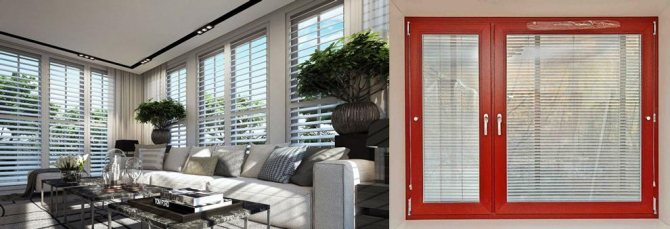

Varieties by material of manufacture
The main criterion by which ready-made horizontal blinds are divided into types is the material of their manufacture.
Plastic


The main advantages of plastic products are the low price and the widest choice of colors. They are made from two polymers, these are:
- Polyvinyl chloride (PVC, PVC);
- UF - polymer (UV polymer).
Polyvinyl chloride is the most common polymer in the industry. It has one significant drawback: under prolonged exposure to ultraviolet rays, it loses its consumer properties and cracks. To prevent this trouble, light-absorbing dyes are introduced into its composition, which significantly extends the service life of finished products.
UV - polymers of ultraviolet curing of higher quality than PVC, resistant to direct sunlight. Visually, lamellas made of UV plastic do not differ from those made of PVC, but they serve much longer without loss of presentability and operational properties and, accordingly, are more expensive.
The most popular of these designs are white, but in fact they can be painted in any other color. In addition, outwardly, they can imitate other materials: wood, metal, textiles, and recently horizontal blinds with a pattern (pattern or photo printing) have become very popular.
Plastic and aluminum strips retain their shape due to a special bend that runs along their entire length.
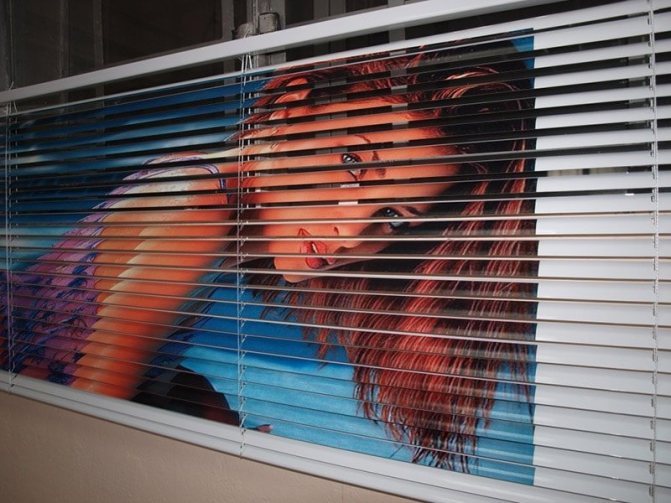

Any pattern can be applied to the plastic slats, if desired.
Aluminum
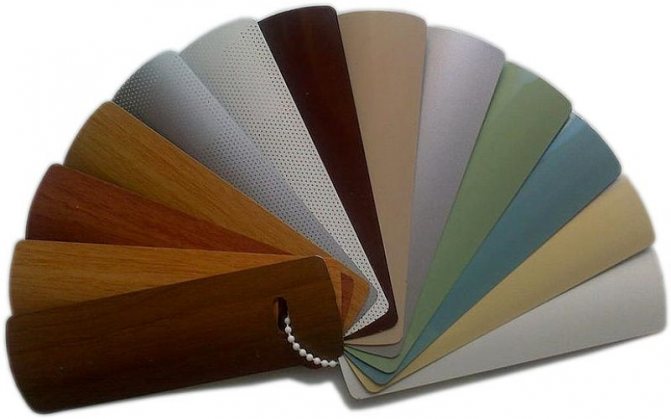

If we consider the types of lamellar light-shielding structures from the point of view of functionality, durability and efficiency of light protection, then the best of them, of course, are metal, or rather, aluminum, covered with a decorative polymer layer on top. Such a coating ennobles them without compromising performance.
Aluminum models are as light and thin as plastic ones, but stronger and more durable, and thanks to a special coating they do not corrode.
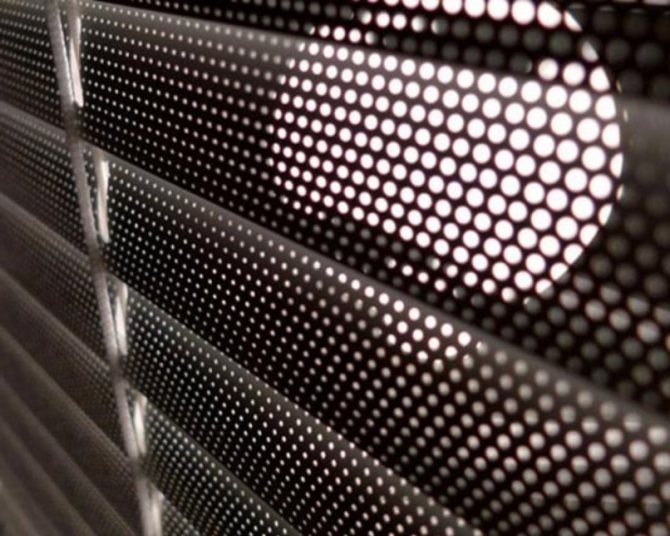

Perforated aluminum blinds create a special, eye-pleasing lighting in the room.
The entire range of horizontal aluminum blinds on the market can be conditionally divided into three groups in appearance:
- Classic. Constructions with conventional lamellas of standard width in silver "aluminum" color.
- Perforated. The slats of such models have many small round holes, through which even they are completely closed, part of the light flux passes, creating a mysterious and cozy atmosphere in the room.
- "Under the tree". In this case, the lamellas of the horizontal metal blinds are covered with a polymer layer imitating natural wood.
Horizontal aluminum blinds first appeared on the market in 1946, when the technologists of the English company Hunter Douglas (a recognized world leader in the production of sun protection systems) of a new method of aluminum casting.
the cloth
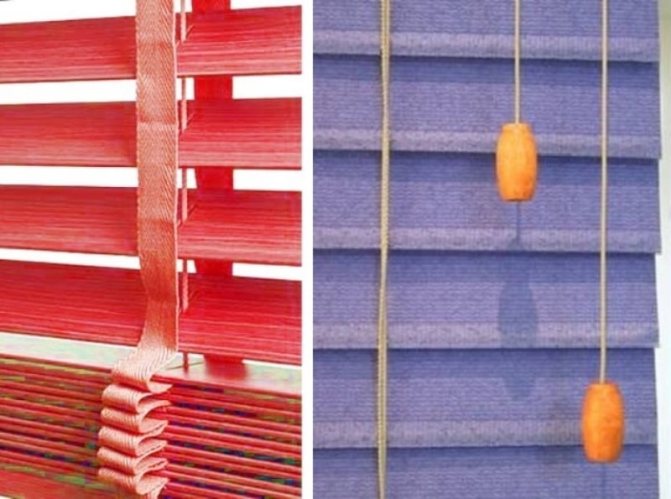

Blinds with slats made of fabric are still underestimated and are rarely found on the market. At the same time, they look very beautiful, cozy and even remotely resemble ordinary curtains.
For their manufacture, polyester, dense jacquard and fiberglass are most often used. Fabric slats are wider than plastic and aluminum ones and have an absolutely flat surface. Their width varies from 5 to 10 cm, as a result of which they are mounted mainly on the entire window opening, and not on the sashes.
With regard to consumer properties, horizontal fabric blinds in their characteristics are almost not inferior to analogues made of PVC and aluminum. During the manufacturing process, they are coated with special impregnations that extend their service life, protect against burnout and allow them to be used even in rooms with high humidity, such as bathrooms.
Wood
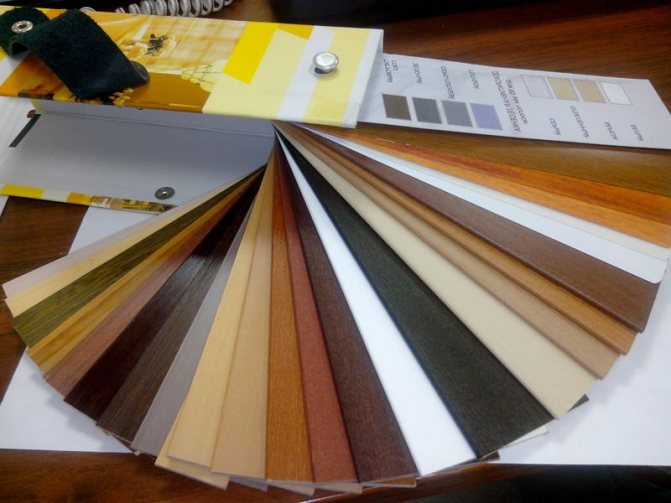

The very first horizontal blinds were made of wood, and they also received the second name - "Venetian". They also consist of many planks, connected by ropes or textile bands, with which you can collect the planks at the top of the window or turn them at an angle, allowing the sun's rays to enter the room. Their sizes can be different, but on average, their width varies from 3 to 12 cm.
First of all, wooden horizontal blinds are valued for their environmental friendliness, durability and nobility. They look perfect in high-status interiors with natural wood furniture and are equally appropriate in the home environment and in the atmosphere of respectable offices.In the manufacturing process, wooden planks are coated with special compounds that give them such qualities as resistance to moisture and fading and extend their service life.
The cost of wooden structures primarily depends on the quality and type of wood used for their manufacture, and the price of different products can differ very significantly.
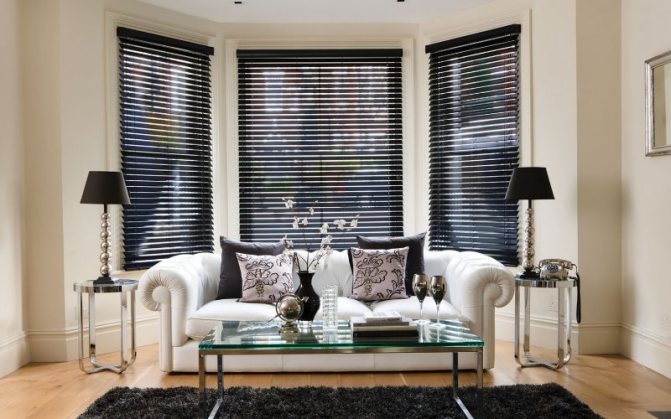

A classic of the genre - wooden blinds look very status and presentable.
For those who want to decorate windows respectably and at the same time save money, a way out of the situation will be to buy Faux blinds, made of material made using a special technology that allows you to combine natural and artificial materials. Externally, horizontal blinds under a tree do not differ from wooden or bamboo, especially since wood particles are present in their composition, and at the same time they are quite budgetary.
The consumer properties of Faux systems are higher than those of 100% wood. They are able to withstand significant temperature extremes and high humidity, and unlike, for example, the same horizontal plastic wood-like blinds, they not only look like natural products, but also contain wooden elements.
Another budget option for wooden sunscreens is horizontal bamboo blinds. They can be made in the form of a continuous roll cloth, assembled from a large number of small boards, and in the classic version. In the latter case, they consist of planks made of pressed bamboo stalks. Bamboo horizontal systems are durable, environmentally friendly and in high demand.
Free hanging
Free hanging aluminum horizontal blinds
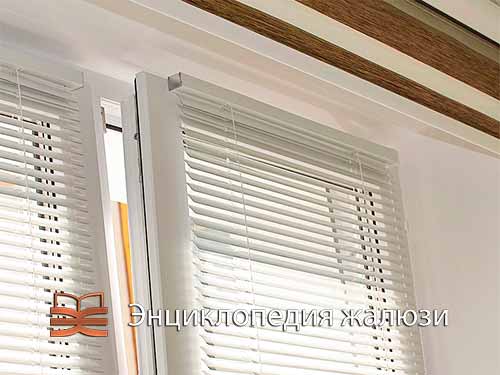

The free-hanging design allows you to simultaneously close the entire window opening or divide it into any arbitrary number of louvered sections. The material and construction of the windows can be of any kind. As the name implies, these blinds simply hang freely at some distance from the window without any additional fasteners and guides, except for the top one.
- Cassette
Varieties by type of management
There are only two control options for any light-shielding structures: manual (mechanical) and automatic (electrical).
Manual control
When operated manually, the process of adjusting the angle of inclination of the lamellas, as well as their lifting, fixing at a certain height and lowering, takes place with the help of a rope and a rotating cane. The reed can be positioned either on the left or on the right. It is not difficult to use a manual mechanism, but there are some subtleties here: you need to do it smoothly, without jerks and efforts, otherwise you will break or entangle the rope.
In order to raise the planks to the desired height, you need to gently pull on the control rope, and then take it to the side where the control cane is located. With this movement, you will set the lock in motion, and the blinds will be fixed at the height you need.
But more often than not, lifting the canvases is not necessary, since the intensity of illumination is most conveniently adjusted when they are completely lowered. To do this, it is enough to rotate the cane, thereby setting the planks at the angle necessary for comfortable light protection.
Remember that if you pull too hard or jerk on the control rope too much, the entire mechanism may be damaged.
Automatic control
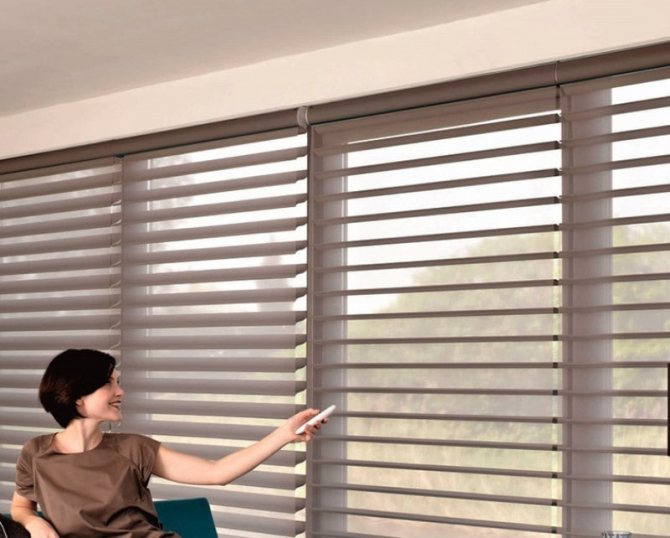

With automatic control, the mechanism is driven by an electric motor, which is switched on using the remote control. Of course, this is very convenient, but also expensive and does not make sense in all cases. Naturally, if you are installing blinds in a small kitchen, or a bathroom with a standard window, you should not spend money on an electronic control mechanism. But sometimes it is difficult to do without it.
Usually, horizontal blinds with an electric drive are tried to be used in the following cases:
- windows are located on two floors at once, large in size or located in hard-to-reach places;
- there are too many windows in the house and manual lighting control becomes time consuming;
- there are several windows in the room and it is often necessary to adjust their light protection synchronously.
There are several types of automatic control from the simplest, which differs from manual only in that the adjustment of the position of the slats occurs remotely, to complex electronic devices. The latter are equipped with sensors and a timer, thanks to which the slats open and close independently depending on the time of day, and their angle of inclination changes depending on the intensity of sunlight outside the window.
Main characteristics
The lowering, lifting and swinging mechanism works on the basis of a modular chain. It is installed in any part of the glass unit. This moment is agreed at the stage of manufacturing the structure, further change of the parameter is impossible.
The metal lamellas are available in white, silver, gray or gold. The shade of the control elements is selected in accordance with the execution of the frames.
The dimensions of the structure are different. The minimum values are 40 × 20 cm, the maximum - 130 × 230 cm. The largest area of a glass unit with shutters inside the window is 3 m². When selecting the thickness, the standard values of 2 or 2.4 cm are used.


Classic and cassette models
There is another classification according to which horizontal blinds can be divided into two large groups. They can be:
- Classic.
- Cassette.
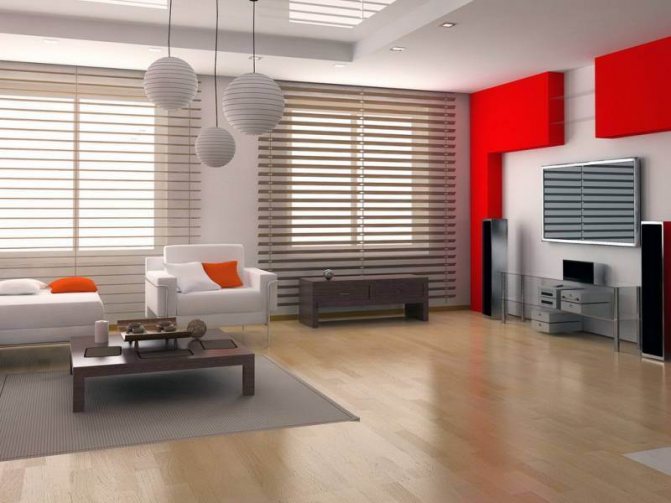

Classic blinds for wooden windows appeared on our market in the early 90s of the last century, when euro windows were not yet widespread and were considered exotic. They are canvases of strips arranged one above the other, fixed on a U-shaped cornice. Control is carried out with a cane and rope. They are installed in the opening, on the opening or on each sash using drilling. When installing on the sashes, it is advisable to choose models with side holes and metal strings or nylon lines that stretch the canvases on the sashes and do not allow them to dangle when opening the windows.
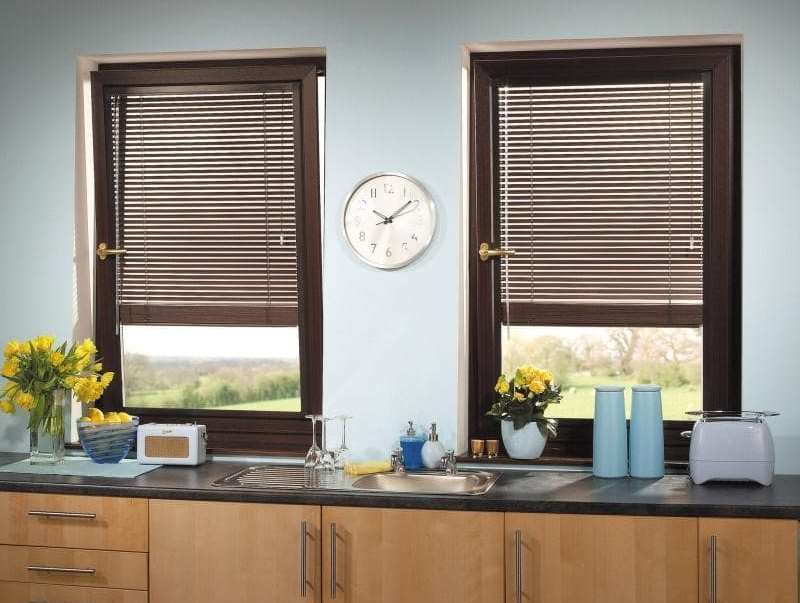

Cassette blinds appeared on the market in the early 200s and were developed specifically for plastic windows. Cassette systems are gradually replacing traditional options, since they are more convenient to use. When lifting, the entire canvas is hidden inside a small cassette, and the slats themselves slide along the side guides, which do not allow them to dangle when the window is open and controlled only by a chain. To turn the lamellae, you need to slightly pull on it, and to raise it, pull it harder. The cassette itself protects the assembled canvas from dust and improves the aesthetic perception of the entire window decoration.
Classic and cassette blinds in comparison
The control chain with which the cassette blinds are equipped is much shorter, that is, when the blades are raised, it does not have a long end, which constantly threatens to get confused. In contrast, in classic models, when they are raised to the very top, the length of the cord doubles.
Another difference between cassette models is that they are not attached to the frame, but strictly to the glazing bead. When it comes to Euro windows, this is more correct, since glazing beads, if necessary, can be easily changed in any window company. In addition, the lateral fixation is more accurate and inconspicuous.
A significant advantage of cassette designs is that their lamellas are installed on the sash close to the glass and thereby provide better light protection. In classic designs, the canvases during installation remain from the glass at a distance equal to the glazing bead depth plus 4-5 mm.
For the sake of fairness, it's worth mentioning that conventional systems are easier to remove for cleaning. To do this, simply unfasten them from the brackets. To dismantle the cassette blinds, you will have to unscrew the screws. But on the other hand, since they fit snugly and evenly to the glass, there is no need to remove them every time to clean. From time to time, you can unfold the slats into a single canvas and wipe it gently with a cloth. With the help of such a simple method, even soiled white slats are cleaned of dust and dirt easily and quickly.
Thus, it is better to install cassette blinds on euro windows with a good glazing bead depth (from 8 mm). For old wooden windows with a glazing bead depth of less than 8 mm, classic-type constructions are better suited.
Arrangement and installation of blinds on windows (instruction), help in choosing blinds
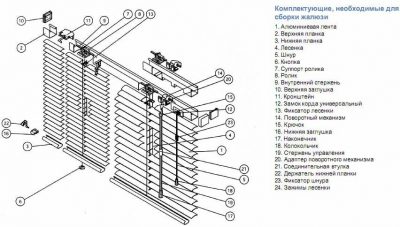

Blinds are an effective and technological accessory, the demand for which determines the development of new and improvement of existing models. The price range of this accessory is wide - from quite affordable roller blinds with fixed blades to expensive electric devices.
Non-standard designs
Modern technologies make it possible to harmoniously integrate horizontal blinds into any window structure, endowing them with wide functionality.
In fact, there are plenty of various modifications of horizontal blinds for plastic windows and from time to time manufacturers come up with something new, further expanding the richest range of these universal light protection systems. Among them I would especially like to highlight:
- Inclined.
- Interframe.
- Retro.


Tilted horizontal blinds are specially designed for installation on tilted or beveled window frames, taking into account all the features and nuances of such windows. On both sides of such products, cables are provided that hold them parallel to the glass at any angle of inclination of the frame.
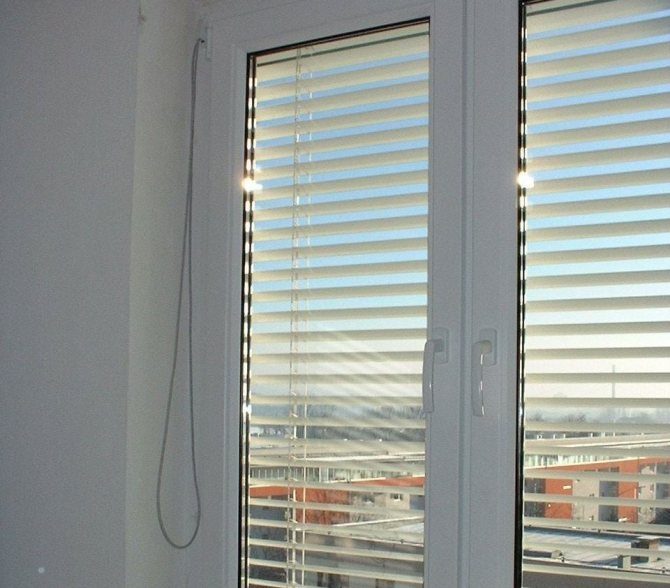

Horizontal interframe blinds are placed between the panes and save space to the maximum. Usually they are white or colorless and do not carry a decorative load in the interior. This arrangement of interframe systems is possible for both old timber and European window structures. The main condition is that the distance between the glasses must be at least 30 mm. In this case, the control is carried out, therefore, in order to raise and lower the lamellas and adjust their angle of inclination, it is not necessary to open the frame.


Blinds "Retro" differ from all others in a more aesthetic appearance, thanks to a decorative textile ladder 2.5 cm wide. The same ladder was once used on the first blinds from Hampton. According to the material of manufacture, they can be bamboo, wood, textile, less often aluminum or PVC, but coated with wood, leather or fabric.
The webbing is usually made in the same color as the lamellas and completely hides the hoisting ropes and the holes through which they are passed. To maintain a vintage feel, these retro models eliminate the use of an electric drive.
How are windows with built-in curtains arranged?
Interframe blinds are made from standard materials, but they are installed between two panes. The lamellas are made of durable aluminum alloy at an affordable price. Element width - 1.6 cm.
Parts are standard or perforated. The latter help create soft lighting.
The control system includes the following elements:
- A pen. Used to rotate the lamellas. The handle is fixed on the window with a special lock. The element color is brown or white.
- Control cord. It is used to open or close the canvas. The cord is secured by winding it around the retainer.
- Control wheel. Like the handle, it helps to rotate the slats. Installed on a sash.
The canvas is attached to the inner side of the glass unit frame with steel holders with rivets or Velcro.The flexible control mechanism is brought out through a small opening. Curtains can be built into interior partitions, doors, panoramic glazing.
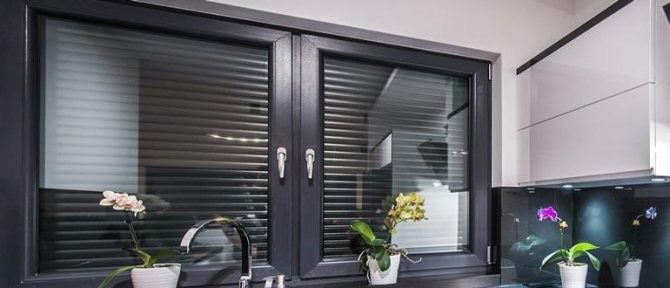

Colors of aluminum lamellas
Colors of aluminum lamellas of horizontal blinds
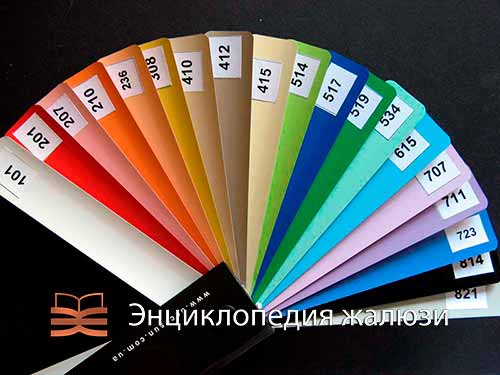

Manufacturers horizontal aluminum blinds with adjustment for windows
offer a wide variety of color shades of lamellas and a variety of original coating textures. It can be classic white, different bright and pastel colors, imitation of wood and other materials. In addition, there are painted patterned finishes, prefabricated patterns and colored fabric surface finishes.
Thanks to this, there is a great opportunity to buy horizontal blinds that perfectly match the interior of any room.
What sizes are
Aluminum blinds have lamellas with a width of 16 to 50 mm. These are the most common items. Their length depends on the width of the window. For standard windows, choose a size of 150x160 cm. If the lamellas are too long, they must be shortened by cutting them with sharp scissors or a knife.
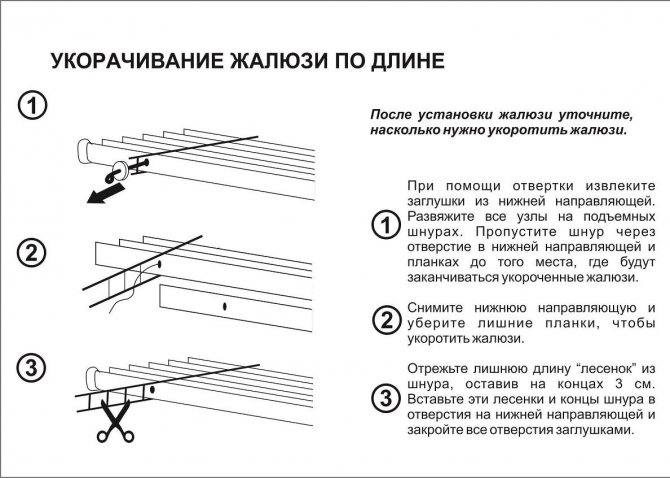

Once the planks have been shortened, they should be leveled with a fine notched file. It is better to order and purchase products according to the size of windows or doors.
